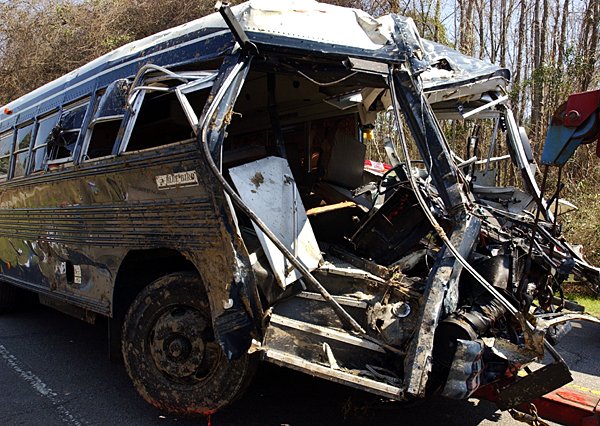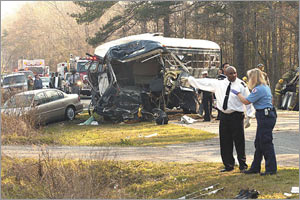
*Working a Mass Casualty Incident*
First let me say this was a real incident. HIPAA laws prevent me from discussing anything that was personal about the individuals involved. The incident was reported in the local and national news, and I won't be giving you any information that isn't readily available, except maybe the experience I gathered from a personal perspective. You can find several news articles about this incident by searching, Navy Bus Wreck, Hwy 17, Garden's Corner, SC. It happened in 2004.
I worked for a small fire department. Besides the Chief, we had four paid personnel on duty each day, providing someone wasn't out sick. Our minimum manning was three. We had three shifts, on a 24hour on, 48 hour off schedule. We had around fifty firefighters with various levels of training when you add up paid and volunteer staff, but obviously they weren't all available all the time. EMS was a county-wide system, but the county was, and still is broken into several fire districts. Our fire district was the second largest as far as land mass goes, and the second smallest as far as staffing went. The incident I'm going to discuss happened at shift change between A and B shift, at around 8 in the morning. I worked C shift, so I was home with my then one year old daughter when the call went out.
Part of A shift was finishing up a wreck at one location when the pagers dropped tones for another wreck. I listened, knowing that part of the department was already at a wreck, and also mentally running through the possibilities of where I could take my daughter if the wreck was bad…never really thinking it would be. When the squad pulled up on scene, I heard the on duty firefighter say "Dispatch we have…. 15…. 20…30… Dispatch I don't know how many PIs (PI=Patients Injured) …… Just send me everything you've got!"
Then a long silence. This particular firefighter was only trained to a First Responder level, but he had been on the department for fifteen years. He didn't get excited about calls anymore. He was faced with a wreck involving two fully loaded buses, an eighteen wheeler carrying cargo, and a passenger vehicle. Luckily one of the Paramedics, who was part of the oncoming shift rode with him to the call, but she only had very basic equipment. All of this was readily understood by all of us listening in on the pagers. We knew that it was bad by the sound of the firefighter's voice.
I packed my daughter into the car and headed to a neighbor's house to drop her off before going to the call. I don't know how long it took for me to get there, but realistically not more than ten minutes. The wreck had both lanes of highway 17, the main roadway between Charleston, SC and Savannah, GA shut down in both directions. The only way to access the scene was to drive the wrong way down the narrow two lane road, and hope that people choosing to avoid traffic by turning around were being watchful for emergency response vehicles.
When I arrived on scene, a Unified Command had already been established. The Fire Department is ultimately in charge, but EMS was handling triage and transport, while the fire department helps and handles extrication and safety. The Department of Motor Vehicles was on scene fairly quickly as well and they immediately began to re-direct traffic. The Fire Department called for mutual aid from other departments and there were a total of six departments that responded. All of these departments, from three different counties had some sort of mutual aid (they respond when called), or automatic aid (they respond to certain incidents automatically without waiting to be called) with our department. We had four medical transport helicopters circling, news helicopters, LEO from various agencies… not to mention the US Navy. The two buses had been carrying Navy Sailors who were on their way to a ceremony in Beaufort.

It seems like it would have been wall to wall chaos, but it wasn't. You find out very quickly that you can only deal with one patient at the time.
For my part, I went from patient to patient, bandaged, splinted, held C-spine, or whatever was appropriate for that patient, then helped package the patient for transport. Once EMS took that patient, I moved on to the next. When the last patient was taken to the hospital, and the bodies extracted, we went back to the station to restock and de-brief. Even then, immediately after the incident, I couldn't tell you exactly how many patients I personally helped triage and package. My best guess is that it was somewhere between seven and nine. Sometimes the patients were transported immediately and sometimes they had to wait for an available ambulance.
I'm an EMT-B. We categorized patients as Green for walking wounded, Yellow for Urgent, but whose condition would not worsen to critical if they had to wait a short time, Red for those who needed immediate transport, and Black for deceased, or fatally wounded. I worked with the Yellow patients mostly and left the Reds for Paramedics… All of the Greens and the few Blacks had to wait. The driver of the eighteen-wheeler was originally categorized as a "Black", or fatally wounded patient, until we had enough resources to extricate him from the badly mangled cab of his truck. He survived. Three Navy Sailors were pronounced dead on the scene.
This was a true Mass Casualty Incident, which in very practical terms just means a single incident with more casualties than you can handle with your immediately available resources. We certainly had that. The wreck, and the way we handled it, are still the standard by which other major incidents in that area are judged. Not because we did everything perfectly…we didn't, but because most departments train for Mass Casualty Incidents, but not many have to actually work one. The news reports vary, but I was there so I know the correct numbers…not because I remember them mind you, but because I saw the actual reports. We transported 72 patients, some by ambulance and some in buses. That's a lot of patients, and it doesn't count the three who didn't make it.
Here's what I learned from that call. Practice, Practice, Practice…. No surprise there. You respond the way you are trained to respond. We made some mistakes. For instance, we had backpacks prepared with bandaging and other supplies to use in the event of a hurricane for search and rescue. None of us thought to grab them. We worked with supplies straight off of the Fire Department apparatus, which was fine because we didn't run out. None of us thought to use the color coded identification tags for triage. Still, everyone was transported as quickly as possible, and no major transport mistakes were made. I doubt the outcome would have been quite as favorable if the buses had been carrying senior citizens instead of healthy young Sailors. The damage to the buses and eighteen-wheeler was significant.
I think that it is important for everyone to know what their local Fire Department is capable of handling. The Fire Department I worked for would not have been able to handle this wreck nearly as effectively without help from surrounding departments, and training with those departments. If there been a patient having a heart attack during the time of this incident, we would have had help on the way, but the response time would have been much longer than usual.

One of the Paramedics discussing the scene with the Director of EMS. At this time, there are still two bodies under the car you see near the bus. You can't see the second bus. The fire department you see in the background is from one county over. The firefighters you can see in the back and to the right of the photo were from my department.
How big is your Fire Department? How big does an incident fin your AO need to be in order for the incident to be considered a Mass Casualty Incident? What nearby departments will respond to assist your local Emergency Response Personnel if needed? How far away does your department respond in order to help others? Will this leave your area without adequate coverage?
It doesn't take a full blown, nothing is working ACOMS situation to tax your local emergency resources beyond their capacity.
Leslie
www.alpharubicon.com
All materials at this site not otherwise credited are Copyright © 1996 - 2012 Trip Williams. All rights reserved. May be reproduced for personal use only. Use of any material contained herein is subject to stated terms or written permission.